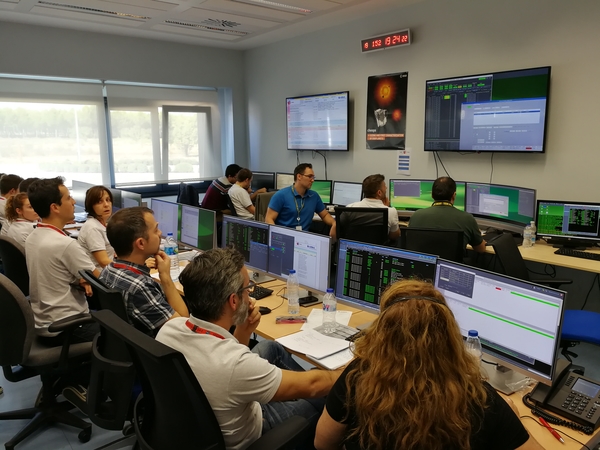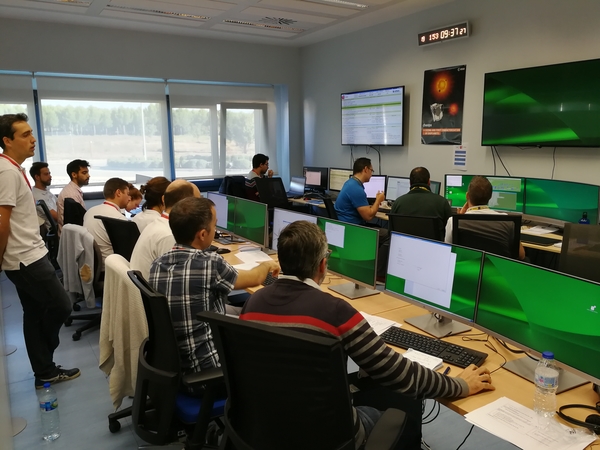#15: A jigsaw falling into place: CHEOPS end-to-end testing complete
12 February 2019
After a successful series of tests, the team that will operate the CHEOPS mission is ready for the activities to follow the satellite launch later this year. |
| The CHEOPS Mission Operations Centre. Credit: ESA/C. Corral |
The CHEOPS satellite has been allocated a launch window between 15 October and 14 November. Once launched, the satellite will separate from the Soyuz vehicle to navigate the cold vacuum of space alone. A carefully choreographed sequence of actions will be initiated remotely by a team of satellite operators who will activate the craft's subsystems and prepare for the start of astronomical observations.
Once in orbit, opportunities to repair CHEOPS will be limited to software fixes, so it is important that everything works first time. Space engineering is hard. The one-shot deployment of unique, complex machines into an environment that cannot be entirely recreated on Earth leaves little margin for error. In few other fields of human endeavour is preparation and testing so vital.
| CHEOPS in orbit. Click here for details and large versions of the video. Credit: ESA/ATG medialab |
Between 11 and 14 December 2018, the very last of the System Validation Tests (SVT-3) was completed. This test was the culmination of a series of system validation tests, reported in CHEOPS journals #4 (SVT-0), #8 (SVT-1A), #10 (SVT-1B) and #12 (SVT-2).
During SVT-3, the flight model of the CHEOPS satellite, situated in the clean room of Airbus Defence and Space Spain in Madrid, was controlled from the Mission Operations Centre (MOC) thirty kilometres away, in nearby Torrejón, and data was exchanged with the Science Operations Centre (SOC) at the University of Geneva, Switzerland.
 |
| The CHEOPS Mission Operations Centre. Credit: ESA/C. Corral |
The SVT-3 tests were used to evaluate the end-to-end operation of the satellite during the Launch and Early Operations Phase (LEOP), the In-Orbit Commissioning (IOC) phase, and nominal operations.
LEOP refers to the critical sequence of events that will be performed in the first days after launch. It will be followed by the In-Orbit Commissioning (IOC) phase, lasting around two months, when the spacecraft platform and the science instrument will be readied for science operations. During nominal operations, mission planners at the SOC will define a weekly activity plan that will be verified by satellite operators at the MOC and uploaded to the spacecraft. Science data gathered by the satellite will be sent to a ground station and relayed to scientists at the SOC via the MOC.
Prior to the tests, the latest version of the science instrument software was installed remotely, via uplink, as would happen for any post-launch software updates. This and all other test procedures were executed to the satisfaction of the test engineers.
A major milestone awaits the mission at the end of February, when the qualification and acceptance review of CHEOPS will be completed. This is an important process during which ESA scrutinises the cumulative set of test results, including the SVT-3 results, to determine whether the qualification and acceptance of the satellite has been successfully achieved by the prime contractor, Airbus Defence and Space Spain.
Besides this review, and any activities arising from it, further preparations will focus on rehearsing in-flight procedures using a virtual satellite simulator, which will be used to train the operators in the Flight Control Team during the simulation campaign in the months leading up to launch.
For CHEOPS, the period of preparation and testing is drawing to a close. The scientific prize, won through painstaking technical exactitude, is almost within reach.
About CHEOPS
CHEOPS is an ESA mission implemented in partnership with Switzerland, through the Swiss Space Office (SSO). The University of Bern leads a consortium of 11 ESA Member States contributing to the mission and represented in the CHEOPS Science Team. ESA is the mission architect responsible for overall mission definition and procurement of the spacecraft and launch. ESA is also responsible for the early operations phase that will be executed by the spacecraft contractor, Airbus Defence and Space–Spain (ASE). The science instrument is led by the University of Bern, with important contributions from Austria, Belgium, Germany and Italy. Other contributions to the science instrument, in the form of hardware or science operations, are provided by Hungary, France, Portugal, Sweden, and the United Kingdom. CHEOPS will be launched from Europe's spaceport in Kourou, French Guiana, on a Soyuz rocket operated by Arianespace. Following successful in-orbit commissioning of the spacecraft, responsibility for operations will be taken over by the CHEOPS Mission Consortium, with the Mission Operations Centre under the responsibility of INTA, Spain, and the Science Operations Centre led by the University of Geneva, Switzerland.



